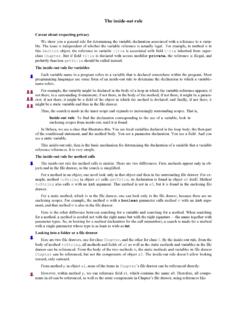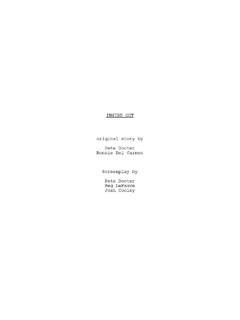Transcription of INSIDE OUT: LESSON PLAN 1 WORKING WITH YOUNG …
1 INSIDE OUT: LESSON PLAN 1 WORKING WITH YOUNG CAMPERS AUTHOR(S): Asya Gribov SUMMARY: Using the movie INSIDE OUT as a framework for understanding behaviors, participants will engage in various role play activities to develop strategies to improve communication among one another. TOPIC(S): Communication Skills, Community Building, Group Dynamics, Leadership Development, Theater, YOUNG Children LEARNING OBJECTIVE: Participants will work to better understand personal motivations and behaviors and explore effective communication tools. AUDIENCE: Staff, specialists, and counselors; group size can vary TIMING: 75-90 Minutes APPENDICES: Asya Gribov Specialty Track 1 INSIDE OUT Handout 1 MATERIALS NEEDED: AV Set Up to watch YouTube Videos Post its SET-UP DETAILS: AV Set Up to watch YouTube Videos SESSION TIMELINE AND OUTLINE: Ice Breaker: (10-15 minutes) Participants stand in two lines facing each other with enough space for comfortable communication between partners and the others are standing side by side.
2 After allowing ample time for participants answer first question, ask 1 row to shift over so that everyone has a new partner. Repeat as necessary. Question Prompts: What is your name? What was your favorite toy or game as a child? What is a vivid memory you have of yourself as a camper? (Facilitator can share own story.) Did you have a childhood nickname? If so, what was it? Can you remember a time that you, as a child, were misunderstood by adults? Miscommunicating with Campers Role-play: (20 minutes) Taking turns, participants role-play difficult scenarios between counselors and campers. (Tip: instruct the actors not to give in.) Variation: other participants can tap our actors at any moment if they feel they can add anything to the situation. Facilitator can solicit situations from the participants or use predetermined scenarios. Suggested Scenarios: Camper refuses to go swimming because they are afraid Camper is crying because they are homesick Camper refuses to eat Two campers are fighting and counselors comes in to deal with the situation Camper wet their bed and is embarrassed Camper hates role-plays Camper feels lonely, and doesn t have any friends Camper is acting out and throwing things Discuss: What is happening?
3 Is there miscommunication? How does it feel when the other person doesn t understand you? How are children limited in their ability to express their problems? How can we help our campers express themselves? How can we empower ourselves understand what they need? How can we create a common language between counselors and campers that can help communication? What s going on INSIDE their heads? (20 minutes) Watch INSIDE OUT Joy Introduces Emotions: Discussion: What are some of your initial thoughts? (write them down) How can we use INSIDE OUT to help us understand what others are feeling, or what is motivating different behaviors? Introduce the INSIDE OUT Poster: (15 minutes) What does the Jewish tradition say about each of these emotions? (Hand out poster) Going over the handout as a large group, participants will discuss the role of the emotions and study Jewish connects that speak to the role of each of the emotions for people.
4 How can we use INSIDE OUT to create a common language between camp staff and campers? How can we pause to think about our emotions, other emotions prior to acting? What does it sound like for the emotion to have a conversation with the Jewish text? Dealing with Homesickness (10 minutes) Watch clip Sadness Understands Bing Bong Discuss: What can we take away from this scene? What s the importance of acknowledging someone s feelings? What is empathy? How can we be empathetic to our campers? How can we help campers be empathic toward each other? How can we talk about homesickness with our campers? What can we do to help them understand their feelings? Rewind Role-play (15 minutes) Looking back at the previously played scenarios how can we adjust our conversations to include the new common language of emotions. How can we teach campers to be aware of their emotions?
5 Participants repeat the scenarios, but this time both roles of campers and counselors can use the language provided by INSIDE OUT to deal with the emotions. Participants repeat scenarios giving voice to the emotions. Exit Activity As participants exit (or throughout the session) they will write their ideas on the posts and paste on boards under the following headings: Difficulties of WORKING with YOUNG campers Advantages of WORKING with YOUNG campers ADDITIONAL NOTES FOR BRINGING IT BACK TO CAMP: The workshop is developed as a training for staff for WORKING with campers. It may be adapted accordingly to deepen communication and social skills between campers. INSIDE OUT: LESSON PLAN 2 A KID S MIND AUTHOR(S): Asya Gribov SUMMARY: Participants will read and act out the short story Rooster Prince of Breslov. Participants will make memory boxes to store camp memories in. TOPIC(S): Bedtime Ritual, YOUNG Children LEARNING OBJECTIVE: Participants will gain tools for creating meaningful experiences on the first day of camp as well as bedtime rituals.
6 AUDIENCE: Staff, campers, small to medium size group, all ages TIMING: 75-90 Minutes APPENDICES: INSIDE OUT Poster, LESSON 2 Handout (The Rooster Prince) MATERIALS NEEDED: Mini Cereal Boxes or any small box container Art Supplies: white paper, pencils, glue, markers, stickers, construction paper, glitter, natural materials, decorations SET-UP DETAILS: AV with ability to watch YouTube Videos SESSION TIMELINE AND OUTLINE: Ice Breaker: (10 minutes) Participants will draw a visual map of how they got here. Facilitator instructs participant to think of 4 meaningful life events that brought them to this place. Participants will draw these four events on a piece of paper without using any words. Share in small groups. Unpacking the First Day of Camp: (20 minutes) Watch Riley s First Day of School: Discuss: What is going on INSIDE kids mind on first day of camp? What does it mean to be the first camp experience for YOUNG campers?
7 What are you planning for the first day of camp? How can you ensure that this is a positive experience for campers? Idea share: WORKING in small groups, counselors come up with activities to welcome campers on the first day of camp. Giving Instructions to Campers: (10 minutes) Act out Reading: The Rooster Prince of Breslov (Handout 2 at the end of the LESSON ) Facilitator selects a few actors and assigns roles of characters in the story. As the facilitator reads the story, the actors act out the story. Watch video of Bing Bong reading sign for Shortcut: Discussion: (10 minutes) What are some of the challenges of setting rules or expectations with kids? What is an issue with having bunk rules? What are some alternatives? What are abstract rules vs. concrete rules? (be nice, no hitting, etc.) What is the difference between dumbing down things and explaining them with developmentally appropriate concepts?
8 What are some effective strategies you used to manage behavior in camp? o Do vs. don t do o Detailed instructions o Choice of options o Reasonable expectations o Picking your battles o Building rapport with campers (deposits and withdrawals) Bedtime Activity: (40 minutes) Discussion Questions: How can bedtime be a meaningful experience for campers? How can we ensure that kids remember the best memories from camp? How do you close out the day with your campers? Why is it important to give individualized attention to campers? The Shema allows us to reflect on our day and make sure that the last thoughts prior to sleep are positive ones. Watch clip from INSIDE OUT: Riley Going to Sleep Activity: Create your own Long Term Memory Storage Participants will cover recycling mini-cereal boxes and decorate to make personal memory boxes. Using available art supplies, participants will decorate and individualize their own personal memory boxes.
9 Participants will be able to use these memory boxes to record and store their experiences in (similar to a journal). Ask participants to put in a memory from their day or session into the box. ADDITIONAL NOTES FOR BRINGING IT BACK TO CAMP: Can be adapted to various ages. INSIDE OUT: LESSON 2 HANDOUT The Rooster Prince (A Jewish Parable) Text: Amy Friedman and Meredith Johnson Once upon a time a prince lived with his parents in a city in Eastern Europe. Every day the king gave his son tasks and instructions for how to behave. "Be polite to all the elders. Be kind to all the girls. Always dress like a prince. Behave in a princely fashion. Speak this way, walk that way .." The king and queen selected the prince's music, the books he read, his friends and his foes, his food and his fun. One day that otherwise seemed most ordinary, the prince woke at dawn, sat up and began to crow like a rooster.
10 At first no one paid much attention, but when he took off his clothes and waddled downstairs, still crowing at the top of his lungs, the servants began to laugh. The queen was in the kitchen eating breakfast, and when she saw her son, she gasped. "My dear, go put on some clothes! You're not behaving like a prince!" But the prince ignored her and crouched under the table where he began to peck at the crumbs on the floor, just as a rooster might. The king scowled. "This is hardly princely behavior. We are not amused!" But no matter what the king and queen said or did, the prince crowed and waddled and pecked and behaved in every way like a rooster, not like a prince. That evening, instead of going to his room, the prince padded out to the barn, and there he spent the night. At dawn he opened his eyes and began to crow, and soon he trundled back into the house to sit beneath the kitchen table and peck at the crumbs on the floor.









